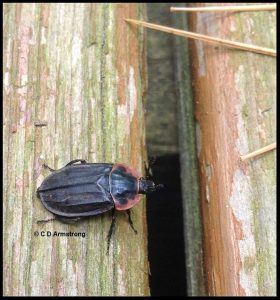Margined Carrion Beetle

The Margined Carrion Beetle (Oiceoptoma noveboracense) belongs to a family of carrion beetles called Silphidae. It has a salmon-colored ‘margin’ along the sides and edges of its mostly black thorax (the wide shield-like section between its head and abdomen). By contrast, the area surrounding the black portion of the thorax on the American Carrion Beetle is larger and has a very pale yellow or off-white coloration to it.
The Margined carrion beetle has a geographic range that extends throughout most of eastern North America and much of Canada (Nova Scotia to Alberta). It is found primarily in deciduous forests but sometimes in grasslands or even marshes on rare occasion. A popular hangout for them around one’s home is at (or near) a compost bin or outdoor garbage bin.
Many species of carrion beetles are active at night, but the Margined carrion beetle is active during the day (diurnal) and is known to be an ‘early arrival’ at a corpse. As adults, they sometimes consume fly larvae that are found on carrion. They’ll also feed on phoretic mites that are notorious for hitching rides on carrion beetles in order to share a potential meal of delicious fly larvae. Consuming the mites also means less competition for any Margined carrion beetle larvae that might also be feasting on fly maggots that are present with the carrion. But the Margined carrion beetle larvae will also feed on the carrion itself as well as on decaying fungi on occasion. And interestingly, both adults and larvae are sometimes found feeding from sap drips on wounded trees, but they otherwise stay close to the ground. The larvae will feed, pupate, and emerge as adults (in late summer) in the span of approximately 45 days. The adults overwinter and there is one generation per year.
Additional Information and Photos:
- Margined Carrion Beetle (BugGuide.net) (includes a link to see a map of their range)
- Photo: Margined Carrion Beetle larva (BugGuide.net)
- See also the similar American Carrion Beetle (BugGuide.net)
